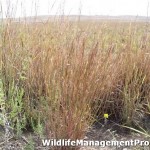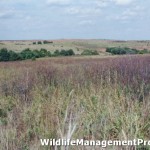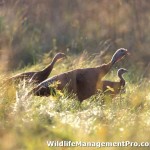Wildlife management through habitat management has become increasingly popular in recent years for both hunters and non-hunters alike. Recreational use of natural resources are now at an all-time high thanks to education, understanding, and promotion of our valuable natural resources. Two birds that many landowners are interested in managing for are bobwhite quail and wild turkey. Both of these birds require diverse habitat, but each has very specific habitat requirements.
Native grasses are at the heart of quail and turkey management. Native grasses for better habitat can be promoted in several ways. More often than not, there is a seed bank within the soil that still contains viable seeds. Some light to moderate disking may encourage these native grass seeds to germinate. Of course, natural grass cover still will not happen over night. Immediately after disking, many low successional forbs (wild flowers and other) will flourish, then it will seem only noxious weeds, and then maybe two, three, or fours years later the manager will start to notice some new grass coming in. A big part of plant response depends on weather conditions.
Landowners interested in improving habitat for quail and turkey can can also disk and over-seed native grass seeds. Even better, landowners can drill seeds directly into the soil. Native grass seed is expensive, so managers implementing this activity should plant grasses in strips. Disk a strip, seed it as recommended, then skip several tractor-widths and repeat. This can be done as little or as much as desired or depending on the landowner’s financial resources. Prescribed burning is also an effective way to set-back habitat and encourage the germination and growth of native grasses.
Simple ground disturbance can help promote native grasses for quail and turkey, but additional planting of seeds will kick start the habitat management program. Quail require bunch-grasses and lots of them. These are the native grasses landowners must provide if they desire quail habitat. Bunch-grasses such as little bluestem, big bluestem, Indiangrass, switchgrass and even sideoats grama. Of course, quail also need seed-producing forbs as well as a woody component consisting of low growing brush.
Turkey are are large-ranging species that often inhabit areas of 2,000 to 10,000 acres in size. Because they have such large home ranges, the best many habitat managers can only provide a small portion of the habitat that they need. Native grasses can accomplish part of this goal, but they also need roosting areas and nesting sites. The availability of water and suitable roost trees are critical for turkey of every species.
In closing, habitat management for both quail and turkey is possible on any size property. However, understand that these animals will sometimes have large ranges, especially turkey. Both bird species require grass cover and woody cover, but in different forms. Quail prefer low-growing shrubs for hiding and loafing, while turkey prefer large trees for roosting. Persons interested in quail management and turkey management should plants pastures and open areas to native grasses for best results.


